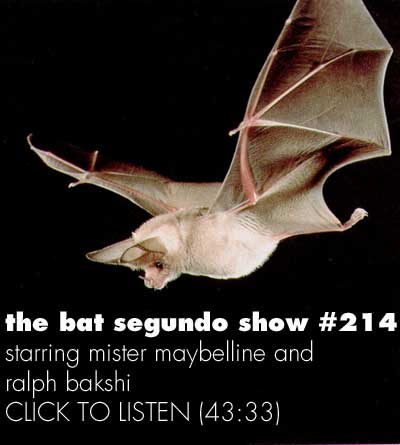Category / Animation
Sesameqatsi?
The Bat Segundo Show: Ralph Bakshi
Ralph Bakshi appeared on The Bat Segundo Show #214. Bakshi is the director of such films as Heavy Traffic, Coonskin, and American Pop. There is also a recent book, Unfiltered: The Complete Ralph Bakshi, now out that collects his work.
Condition of the Show: Caught in a musical daydream.
Guest: Ralph Bakshi
Subjects Discussed: The role of music in Bakshi’s films, making good films without a lot of money, emotionally correct songs, daydreaming, Bakshi’s record collection, the original idea of using Led Zeppelin for Lord of the Ring, Leonard Rosenman, Bakshi’s relationships with composers, Andrew Belling’s Wizards score, the “Maybelline” sequence in Heavy Traffic, artistic freedom, why Bob Seger’s “Night Moves” was the final song in American Pop, the relationship between writing fast scripts and revising in animation, the ending of Heavy Traffic, subconscious symbolism, the use of long shots and extended takes, Sergei Eisenstein, Aleksander Nevsky, giving Thomas Kinkade his first big break, on Fire and Ice not being a Bakshi film, using imagination with pre-existing visual elements, rotoscoping, getting the little artistic details, Edward Hopper, designers vs. montage, operating in the present as an artist, being honest, The Last Days of Coney Island, the impending collapse of America, Barack Obama, burning out, American avarice, and Bill Plympton.
EXCERPT FROM SHOW:
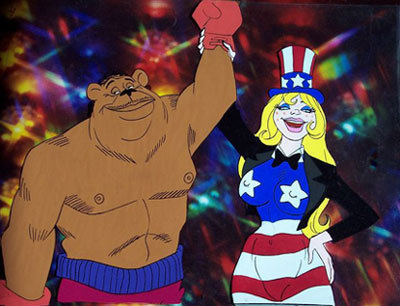 Correspondent: I wanted to ask you about music in your films. It’s certainly important in American Pop. You pilfered from your record collection for that, as well as the “Maybelline” sequence in Heavy Traffic. And there’s “Ah’m a Niggerman” from Coonskin, which you wrote. I’m wondering if you did this because you have an aversion to Carl Stalling-style orchestral music.
Correspondent: I wanted to ask you about music in your films. It’s certainly important in American Pop. You pilfered from your record collection for that, as well as the “Maybelline” sequence in Heavy Traffic. And there’s “Ah’m a Niggerman” from Coonskin, which you wrote. I’m wondering if you did this because you have an aversion to Carl Stalling-style orchestral music.
Bakshi: First of all, I love music. I’ve always loved music. And I’ve loved various kinds of music. Music is part of our lives. It’s part of the soundtrack that what we all grow up with. Especially in my day. I don’t know today. There’s so many things going on. I’m talking about yesterday and my day, which are the 40s, 50s, 60s, and 70s. Music is so emotionally important to the movie. It’s just as important as anything else. If the song is emotionally correct for a scene, the scene plays better. Or the scene plays better than it would have with a different song. So music is so critical to movies. I chose songs that I knew emotionally worked with these scenes that I wrote. Because whenever I listened to music while either driving in a car or sitting at a bar or listening to Coltrane or Billy Holiday – you daydream. If you don’t daydream to music, then you’re not listening to good music.
(Lengthier excerpts from this program can be found here and here.)
Listen: Play in new window | Download

Interview with Ralph Bakshi
I recently had the opportunity to talk with underground animator Ralph Bakshi. A portion of our conversation appears this afternoon at Vulture, where you will discover the song that was originally going to play during the finale of American Pop. (For the specific reasons why, you will have to wait for the podcast.) Unfortunately, there were space constraints. So what follows is some of the additional material that didn’t make it into the piece. The entire conversation, which includes even more from Bakshi, will be released as a future installment of The Bat Segundo Show. (Please note that edited elements of the same conversation appear both here and at Vulture.)

Correspondent: I wanted to ask you about music in your films. It’s certainly important in American Pop. You pilfered from your record collection for that, as well as the “Maybelline” sequence in Heavy Traffic. And there’s “Ah’m a Niggerman” from Coonskin, which you wrote. I’m wondering if you did this because you have an aversion to Carl Stalling-style orchestral music.
Bakshi: First of all, I love music. I’ve always loved music. And I’ve loved various kinds of music. Music is part of our lives. It’s part of the soundtrack that what we all grow up with. Especially in my day. I don’t know today. There’s so many things going on. I’m talking about yesterday and my day, which are the 40s, 50s, 60s, and 70s. Music is so emotionally important to the movie. It’s just as important as anything else. If the song is emotionally correct for a scene, the scene plays better. Or the scene plays better than it would have with a different song. So music is so critical to movies. I chose songs that I knew emotionally worked with these scenes that I wrote. Because whenever I listened to music while either driving in a car or sitting at a bar or listening to Coltrane or Billy Holiday – you daydream. If you don’t daydream to music, then you’re not listening to good music.
I went out and I bought every record that I’ve ever loved that was right for the scene. “Yesterday” by Billie Holiday for Fritz the Cat was perfect for Big Bertha and coming into Harlem. You know, it was a classic song. “Maybelline” and “Twist and Shout.” And all these records. “Scarborough Fair.” All these records I used, I got for fifty to a hundred bucks. They were dirt cheap. I could buy any record I wanted for under two hundred dollars. Why was that? Unbelievable.
Because everybody else was scoring their films. And why were they scoring their films? Because if they had a hit, they’d own the music. They’d make money from the score. They’d own their own records. I can’t release Billie Holiday’s “Yesterday” and make any money out of it. I never considered that. The issue was what was right for the movie. I couldn’t believe the cheap prices I was getting. And I had a low-budget film! So I could afford to get anything I wanted.
Correspondent: But you had Andrew Belling on Wizards. I’m curious if you gave these composers specific instructions.
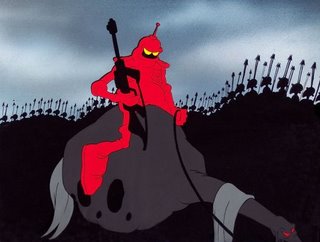 Bakshi: Well, Andrew Belling on Wizards did an absolutely brilliant job. Let’s talk about Wizards. Wizards is very low-budget. One million two. Okay. I’m not going to fall back on my records, because it’s not that kind of movie. I need a score. But I need a score that I love. And I don’t remember how I got to Belling. I’d been to New York with a lot of other guys. But Belling came with a little synthesizer. One little machine which was a very big deal. We didn’t have any orchestra. We had synthesizers. All that music was done with Belling in the room. And he said the right things and he did the right things. And he came back and he played me a piece of music that was beautiful. I think Belling did an incredible job in that song he wrote. And the battle scenes. And the emotion. Belling nailed it. He did it himself and everything. It was all done without an orchestra. It was good.
Bakshi: Well, Andrew Belling on Wizards did an absolutely brilliant job. Let’s talk about Wizards. Wizards is very low-budget. One million two. Okay. I’m not going to fall back on my records, because it’s not that kind of movie. I need a score. But I need a score that I love. And I don’t remember how I got to Belling. I’d been to New York with a lot of other guys. But Belling came with a little synthesizer. One little machine which was a very big deal. We didn’t have any orchestra. We had synthesizers. All that music was done with Belling in the room. And he said the right things and he did the right things. And he came back and he played me a piece of music that was beautiful. I think Belling did an incredible job in that song he wrote. And the battle scenes. And the emotion. Belling nailed it. He did it himself and everything. It was all done without an orchestra. It was good.
Correspondent: This is an interesting conundrum. I think one of the reasons why the “Maybelline” sequence in Heavy Traffic is so stirring is largely because of that music. But here you have a scenario in which someone else is composing music that doesn’t originate from another source.
Bakshi: I was terrified what he would do. I was scared. I was nervous. I had nightmares that it wouldn’t work. And he nailed it. I don’t know how he did it. I had nothing to do with it. How do you talk to another composer about music? Now look. Let’s talk about freedom. I demand freedom as a director. I demand the right to fuck up, to do what I want. I am not about to take that freedom away from another artist. If Belling walks in and says that he’s a composer, and I believe what he has to say and I believe that he’s sensitive enough and I believe it, man, prove it. Go do your music. It’s not my job to write the music for him.
(I also discussed with Baskhi why he hired Thomas Kinkade. In addition to the remarks at Vulture, Bakshi also had this to say.)
Bakshi: In the middle of the picture, [Kinkade] stands up and he says, “I’m going away with Gurney for three weeks. We’re traveling cross country.” And I said, “Well, wait a minute. We’re doing a picture.” “All right. We’ll be back on a certain date. We will paint enough before we go. And when we get back, we’ll double paintings.”
He worked with Frank Frazetta. Those kids, Gurney and Kinkade, painted wonderful paintings so fast. And Frank Frazetta would come in — he was a great illustrator – and show Kinkade a lot of tricks. Both of those guys, when they painted other stuff, when Kinkade painted closer to the Ashcan school, which I loved very much, wonderful. He can sell anything. He opened up galleries. He’s building a city now. He’s raised hundreds of millions of dollars. He owns half of California. So I have nothing against Kinkade. He’s funny. He is like Elmer Gantry. He’s ‘s a great painter. But he likes to make money. And he does. He doesn’t like the stuff he’s painting.
Correspondent: But that’s anathema to your position, which is about making it as true and as honest as possible.
Bakshi: By the time I got to Fire and Ice, I was bitter. It’s not my picture. I was burned out. I was through. Though people may like it, I don’t consider that a Bakshi film. That’s a Frazetta film. That’s me not caring. I was burned out. I was tired. At that point, I was gone. And I did. I closed the studio and then I left. I had no emotional interest in Fire and Ice to tell you the truth.
Interview with Bill Plympton
I’m currently putting the finishing touches on a number of new podcasts, which I anticipate releasing today. But in the meantime, here’s an excerpt from my forthcoming interview with animator Bill Plympton.
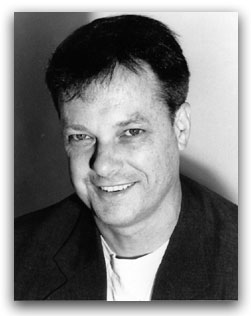 If you don’t know who Bill Plympton is, you’re missing out on one of the most unique independent animators now working in America. Plympton emerged into national consciousness when many of his shorts begin appearing on MTV’s Liquid TV during the late 1980s and early 1990s. This came concomitantly with success on the film festival circuit — in particular, with Spike & Mike’s Sick and Twisted Festival of Animation. But, ironically, his work has found greater appreciation outside of the States. In his own country, he’s considered more of a cult item. Which is too bad. Because if this were a just universe, Plympton would be considered a national treasure.
If you don’t know who Bill Plympton is, you’re missing out on one of the most unique independent animators now working in America. Plympton emerged into national consciousness when many of his shorts begin appearing on MTV’s Liquid TV during the late 1980s and early 1990s. This came concomitantly with success on the film festival circuit — in particular, with Spike & Mike’s Sick and Twisted Festival of Animation. But, ironically, his work has found greater appreciation outside of the States. In his own country, he’s considered more of a cult item. Which is too bad. Because if this were a just universe, Plympton would be considered a national treasure.
I wasn’t surprised at all to see Plympton name-check Winsor McCay during our conversation. There is a fascinating surreal component to all of his films. Take 1994’s “Nose Hair,” in which a pesky and ever-growing follicle kick-starts a wondrous free-associative trip involving a man walking up and down a changing landscape. Or the unusual first-person approach of 1998’s “The Exciting Life of a Tree,” which is told entirely from a tree’s perspective. Couples copulate on a blanket, believing that there is privacy. Other trees are sawed down. But somehow the tree is abandoned.
Plympton puts together his films with a small staff in his New York studio. And, believe it or not, he draws all of the frames himself — at least a hundred drawings a day, he tells me — with his staff coloring and compositing these drawings.
Plympton was kind enough to find a few minutes to talk with me while putting the finishing touches on his most recent animated feature, Idiots and Angels.
(And, incidentally, Plympton tells me that the storyline for the new film involves a disgruntled angel who is a bit peeved that the angel wings force him to be good. As soon as I learn of a release date and/or a distributor, I will follow up.)
Correspondent: I wanted to ask you about something that’s long been curious to me. The suit guys, who have these square shoulders, and who likewise seem to have these very large frames and these very big asses and these very short legs. I’m wondering how this particular look came about.
Plympton: Well, that’s a very good question. Because I see a lot of young animators doing cartoons. And one of the cartoons on the Cartoon Network uses the format that “zany looking people are funny.” Like clowns or animals with big bulbous eyes and huge noses and tongues that stick out and crazy hair. And it’s my feeling that that’s really not funny. For me, humor comes across when you take something that’s normal, that’s placid, that’s bland, that’s a cliche, and do something weird to it. If the main character is weird already when something weird happens, it’s not a surprise. It’s not a shock. Therefore, it’s not funny. So I like to choose characters that are fairly bland. Like vacuum cleaner salesmen. Very normal. And someone you can identify with.
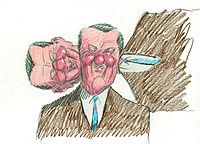 I guess that character, who was originated in “Your Face,” was inspired a little bit by Bud Abbott on Abbott & Costello. The pencil-thin moustache guy with the suit, the slicked back hair. Kind of a sleazy salesman type guy. And that film was such a big success, such a big hit, that I continue that character on through “The Wise Man” and through “Push Comes to Shove,” and a bunch of my feature films — The Tune and Mutant Aliens and I Married a Strange Person. So those films use that character a lot. And I’ve found that he’s a very good character for laughs.
I guess that character, who was originated in “Your Face,” was inspired a little bit by Bud Abbott on Abbott & Costello. The pencil-thin moustache guy with the suit, the slicked back hair. Kind of a sleazy salesman type guy. And that film was such a big success, such a big hit, that I continue that character on through “The Wise Man” and through “Push Comes to Shove,” and a bunch of my feature films — The Tune and Mutant Aliens and I Married a Strange Person. So those films use that character a lot. And I’ve found that he’s a very good character for laughs.
Correspondent: In “Push Comes to Shove,” that character resembles Alfred Hitchcock to some degree.
Plympton: Well, not at all, I don’t think. Because Alfred Hitchcock is really a caricature. And this guy — even though he is a little stockier — there were two guys in “Push Comes to Shove.”
Correspondent: Yeah.
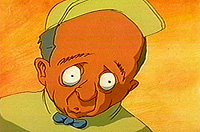 Plympton: A thin guy and a stockier guy. I guess that was inspired by the old Laurel & Hardy gag where they would take an egg and squash it on his head and put the hat back on. It was very dry humor. Very deadpan humor. And then that would escalate. And it escalated into, I don’t know, getting hit by a board or something like that. Well, I wanted to take that escalation and exaggerate it even more. So it becomes so violent and so surreally violent, that it’s just preposterous. And that was my initial inspiration for the film. So Alfred Hitchcock wouldn’t be someone I would say. It was more like Laurel and Hardy. Although even then, Oliver Hardy is more of a caricature than I would want to use. I brought him down as to more of a normal person than Oliver Hardy.
Plympton: A thin guy and a stockier guy. I guess that was inspired by the old Laurel & Hardy gag where they would take an egg and squash it on his head and put the hat back on. It was very dry humor. Very deadpan humor. And then that would escalate. And it escalated into, I don’t know, getting hit by a board or something like that. Well, I wanted to take that escalation and exaggerate it even more. So it becomes so violent and so surreally violent, that it’s just preposterous. And that was my initial inspiration for the film. So Alfred Hitchcock wouldn’t be someone I would say. It was more like Laurel and Hardy. Although even then, Oliver Hardy is more of a caricature than I would want to use. I brought him down as to more of a normal person than Oliver Hardy.
Correspondent: It also reminds me very much of the Fish-Slapping Dance. That kind of one-upmanship between the two characters.
Plympton: Yeah. That’s exactly what the inspiration was.
Correspondent: I wanted to also ask you about some of the perspectives you have. You had a few shorts — and also in your features — where there’s this first-person perspective. I think of the tree, for example.
Plympton: Yeah, “The Exciting Life of a Tree.” “One of Those Days.”
Correspondent: I’m wondering how this came about. Did you need to get away from the typical third-person look of these particular shorts?
Plympton: Well, the magic of animation is that the camera can go anywhere you want. And it’s harder to do that with live action. Although it’s easier now with digital technology. Digital effects. But with animation, you can put the camera anywhere. And that’s part of the fun of it. You’re seeing something that is maybe cliched or boring from a different angle. It makes it exciting. It makes it interesting. And so I wanted to see an event from one person’s POV and see the worst day ever — what it would be — if you lived that life. If you were actually in that person’s place. So it’s very autobiographical in that sense.
But I like to do that a lot. I did another film called “Draw,” where it’s a cliche of two cowboys in a mainstream Texas town. And they draw their guns. Only this is a POV of a bullet. And so again, it’s a kind of cliched, boring situation. But when you see it from the eye of a bullet that is traveling through space, going through someone’s heart, it gives it a whole new perspective. And I love that kind of thing that you can do with animation: change the perspective, change the viewpoint in each shot. And that’s the reason why I love animation.
Correspondent: Is this often why you are drawn to weapons? Not just bullets and cannons and the like. But also chainsaws, I have to ask you about. And cutting people in half. This seems to be a common theme throughout the work.
Plympton: Well, you know, movies have always been violent. Whether it’s Charlie Chaplin or Buster Keaton or Abbott & Costello or the Marx Brothers, violence has always — the Road Runner is a perfect example. Violence has always been part of humor. And so has sex. I don’t know why a lot of Americans are offended by sex in cartoons. It never made sense to me when I grew up with Mae West or Jean Harlow or Marilyn Monroe — there was always sex in adult films. And I just thought cartoons should also have sex. And so the violence is as American as apple pie. And so I like to take the violence and exaggerate it to such an absurd degree that it’s not really scary anymore, it’s funny.
I saw those Saw films and I was really squeamish about it. And it really wasn’t my cup of tea. But I think if they were to have taken that humor and that violence, and exaggerated it to an absurd level, I think it would have been much more interesting and a lot more entertaining.
(The full conversation will appear in a future podcast installment of The Bat Segundo Show.)
